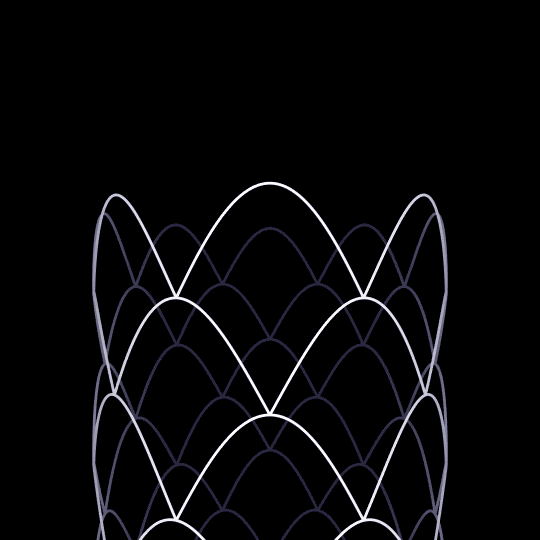








Marie-José Van Hee - House Declercq, Hansbeke 2014. Photos © Crispijn Van Sas.










New work from Cross Connect favorite David Whyte, otherwise known as Bees and Bombs. Dave Whyte lives and works in Dublin as a freelance motion designer. He has a PhD in physics and uses the software Processing to create his elegant and mesmerizing gifs. You can read a longer interview with him here
Posted by David
More unique art on Cross Connect Magazine:










New work from Cross Connect favorite David Whyte, otherwise known as Bees and Bombs. Dave Whyte lives and works in Dublin as a freelance motion designer. He has a PhD in physics and uses the software Processing to create his elegant and mesmerizing gifs. You can read a longer interview with him here
Posted by David
More unique art on Cross Connect Magazine:









Tatiana Kamshilina (Tatiana KawKaw on Tumblr) is from Voronezh, a city in central Russia, and has a degree in architecture, and makes her living doing illustration and 3D visualization related to her degree. However, she loved to draw, then learned to animate on the internet, and like many others became hooked, saying “….it’s like magic, seeing how your character becomes alive and starts moving on its own. Once you’ve made your doodles alive there’s no turning back!” Within her delicate, childlike drawings and simple animations is great sophistication. Her characters feel lifelike in the way they swing their legs or rock back and forth on a sled while reading and her looping is always seamless and clever.
Posted by David
More unique art on Cross Connect Magazine:









Tatiana Kamshilina (Tatiana KawKaw on Tumblr) is from Voronezh, a city in central Russia, and has a degree in architecture, and makes her living doing illustration and 3D visualization related to her degree. However, she loved to draw, then learned to animate on the internet, and like many others became hooked, saying “….it’s like magic, seeing how your character becomes alive and starts moving on its own. Once you’ve made your doodles alive there’s no turning back!” Within her delicate, childlike drawings and simple animations is great sophistication. Her characters feel lifelike in the way they swing their legs or rock back and forth on a sled while reading and her looping is always seamless and clever.
Posted by David
More unique art on Cross Connect Magazine:

 Stress is something we each experience all too frequently. Stress often arises from physical, mental, or emotional strain, and concerns about the future of the nation were the most common cause of stress reported by US citizens in 2017, closely followed by money and then work.
Stress is something we each experience all too frequently. Stress often arises from physical, mental, or emotional strain, and concerns about the future of the nation were the most common cause of stress reported by US citizens in 2017, closely followed by money and then work.
Our bodies don’t generally respond to stressors linearly. A tolerable amount of a stressor can lead to adaptive responses that protect us against similar insults in the future – just think of how your skin bronzes during exposure to a modest amount of summer sun. However, intolerable levels of stressors leave indelible traces of damage in our bodies – we get burnt and may develop things like moles when we’ve spent too long in the sun.
While each stressor we experience has distinct effects, the effects of different stressors accumulate, and when the resultant load is excessive, we’re at increased risk of a range of ailments, from mood disorders to gastrointestinal problems to cardiovascular diseases. So, to avoid the amount of stress we experience exceeding our bodies’ capacities to cope, it would be useful to have a way to monitor how we’re responding to stressors.
In the last few years, numerous wearable devices that claim to monitor how we’re responding to stress have become available, and most of these measure either heart rate variability (HRV) or pulse rate variability. This brings us to the latest episode of humanOS Radio.
In this episode of humanOS Radio I speak with Professor Phyllis Stein, Director of the Heart Rate Variability Lab at Washington University School of Medicine in St Louis. Professor Stein’s lab focuses on identifying markers for cardiovascular mortality, non-cardiovascular mortality, and nervous system dysfunction from continuous recordings of people’s hearts. But she also does work on sleep disorders, such as sleep apnea and other forms of sleep-disordered breathing, and she tries to integrate various physiological parameters to differentiate normal from abnormal sleep, then using the results to stratify people into different categories of risk.
What do you need to know about heart rate variability (HRV)? Are commercial HRV monitors useful? Check out this podcast for more!
Click To Tweet
In this podcast we explore many subjects, including:

On Soundcloud and YouTube
Have you considered becoming a Pro member of humanOS.me? It costs just $9.99 per month, and when you go Pro, you get access to all our courses, tools, recipes, and workouts. Pro members also support our work on blogs and podcasts, so thanks!
If you think other people would benefit from listening to this show, you can help us spread the word by leaving a review at iTunes. Positive reviews really help raise the profile of our show.
| Phyllis Stein: | 00:07 | So in frequency domain HRV, we look at the organization of the heart rate’s signal at different scales, and that tells us a whole lot more clinically than just SDNN, or something like that. |
| Speaker 2: | 00:24 | Human OS, learn, master, achieve. |
| Greg Potter: | 00:34 | Welcome back to Human OS radio. My name is Greg Potter and I’m hosting the show once again. To get up to speed myself, I’ve been keen to speak to somebody smart about heart rate variability, which I’ll often referred to as HRV. So I was very happy when the Dan put me in touch with an expert on this subject. Today I’m joined by Professor Stein, director of the Heart Rate Variability lab at Washington University School of Medicine in St. Louis. |
| Greg Potter: | 00:56 | Professor Steins’ lab focuses on identifying markers for cardiovascular mortality, non-cardiovascular mortality and nervous system dysfunction from continuous recordings of people’s hearts. But she also does work on sleep disorders, such as sleep apnea and other forms of sleep disorder breathing, not to mention integrating various physiological parameters to differentiate normal from abnormal sleep, then using the results for risk stratification. Phyllis, welcome to Human OS radio. |
| Phyllis Stein: | 01:21 | Thank you Greg. Thank you so much. |
| Greg Potter: | 01:23 | Before we get to what I think the majority of listeners will be most interested in, I think it makes sense to start with some fundamentals. So in simple terms, what is heart rate variability and how do you measure it in your research? |
| Phyllis Stein: | 01:35 | That’s an excellent question with a long answer, but I’ll try to make it shorter. We don’t actually measure anything from heart rate per se, what we measure is the time between heart beats, which you think about it, is the same as heart rate. So for example, if someone’s heart rate was a very steady 60 beats a minute, which it shouldn’t be about, let’s say it is, the time between beats is one second or a thousand milliseconds. And that’s what we actually use mathematically. The equivalent. But we actually measure from the time between heartbeats. And we’re only interested in normal heartbeats. And if people don’t know what an abnormal heartbeat is, that would be a heartbeat, that comes way too early, that isn’t part of the normal sequence, and if you are looking at an electrocardiogram, you would see that that beat looked funny. |
| Phyllis Stein: | 02:30 | So we’re only interested in normal beats. Most younger people pretty much having a normal beat. So if you had our listener who’s younger and say, “Oh my God, how do I know?” Don’t worry about it. There’s a better way to say it. If you’re going along on the highway, and there’s a sequence of markers, that’s exactly what we get when we’re looking at recording someone’s heartbeat. We get a sequence of times between beats, and that’s what we use mathematically to derive heart rate variability. I wanna pause there and see if there’s anything I said that wasn’t completely clear. |
| Greg Potter: | 03:04 | That makes perfect sense. Just in case the time comes up in conversation again, when you said abnormal premature heartbeats, so you’re referring to ectopic beats. |
| Phyllis Stein: | 03:12 | Correct. If somebody is more familiar with the terminology [inaudible 00:03:17] and checking of premature beats, atrial premature beats, or junctional beats, that’s the basics. You have a lot of those might make your heart rate very variable, but I think it would be completely obvious to anyone that that kind of heart rate variability is probably not a great idea. Also in a popular mind, more heart rate variability is always[inaudible 00:03:39]. Again, it’s coming from normal regular healthy beats, that might be true. |
| Greg Potter: | 03:43 | I was going to ask you to clarify that higher HRV isn’t always better, so I’m glad you touched on that. Can you briefly overview some of the reasons that clinicians might measure HRV? |
| Phyllis Stein: | 03:52 | Sure. The heart is driven by an internal pacemaker that is working, people get electric pacemakers. But there’s an internal pacemaker, and plan is to make sure that the amount of blood that the heart pushes out on the next beat, is completely matched to what the body needs. And so there’s a lot of feedback loops and brain integration, but fundamentally there are two inputs to this pacemaker. One of them is from the sympathetic nervous system, and the other is from the parasympathetic nervous system. So in the simplest model, the parasympathetic nervous system is the one that slows heart rate down, that leads to a relaxed state. And the sympathetic nervous system is conversely the part that speeds heart rate up, and leads you to get ready to run or fight or something. That’s the simple model. We’ll leave it there for now, but hold on to the thought that that’s really simple. |
| Phyllis Stein: | 04:51 | Basically then, when the parasympathetic signal to the heart, also called the Vagos signal, when the loudness, if you want to call it that, changes the heart rate changes immediately cause of binding, invested calling an immediate fats. When the synthetic side loudness changes, it takes a tiny bit longer for the heart rate to change because of the second messenger signaling properties of the pacemaker of the heart. I wanna call it now the SA node, the sinoatrial node. Basically what that means is that, heart rate variability is telling you something about how the autonomic nervous system, which is the sympathetic and parasympathetic sides of it, are communicating with the heart. And if there’s very little change in heart rate from one beach to the next, and someone is at rest, that’s pretty bad, because it means that your autonomic nervous system is not functioning well at all. |
| Phyllis Stein: | 05:50 | The most condensed way to say this is HRV is, when properly interpreted, a way to look at the functioning of the autonomic nervous system, and potentially to look at whether some intervention makes it better or worse. But you mentioned sleep, so I wanna throw that in here. Sleep apnea, which probably 20% of people have, is when you stop breathing over and over again during sleep, because your throat closes down and you snore a lot. So this is someone who’s sleeping and they are going … I’m not doing it very well, but just continuously waking up to breathe. When that happens, there’s a huge jump in heart rate each time, because the sympathetic nervous system comes on and says, “Wake up, breathe.” And then they fall back to sleep, and it happens over and over again. |
| Phyllis Stein: | 06:43 | So that would be an example of HRV during sleep that would be high but wouldn’t be anything desirable. So going back, you have this list of beats. It could be two minutes, could be five minutes, could be 24 hours, which I prefer. You do mathematical calculations on that list, and it tells you something about how the autonomic nervous system is functioning. And the simplest calculation is average heart rate. So I’m gonna pause here again and see if there’s anything that needs to be clarified, |
| Greg Potter: | 07:16 | We definitely returned to uses of HRV assessment in sleep medicine. I know this is simplistic, but one question that follows from what you just said is, whether you’d say that it’s fair to say that change in the HRV generally reflects how well our bodies are coping with the cumulative burden of stress as we experience. |
| Phyllis Stein: | 07:31 | Yes, in the simplest way. My interest in HRV has led me to be very involved with trauma work and the effect of trauma healing, and the effect of trauma and depression on HRV and all that stuff. It gets complicated, but yes, if you’re within normal range of HRV, it means that your system has the flexibility to deal with experiences. You get up and exercise. If your system couldn’t adjust to the fact that you’ve got up and started moving, then you wouldn’t have a very good exercise capacity at all. |
| Greg Potter: | 08:05 | Speaking of exercise, many people listening may be interested in tracking HRV to monitor autonomic nervous system responses to exercise training. But if HRV is quite variable and holter recordings, often recorded over more than 24 hours by scientists, how much time do people wear monitors to estimate their HRV? |
| Phyllis Stein: | 08:21 | Well, let’s back up to your readership, some of whom are probably staring at their device that’s supposed to measure your HRV, cause there’s a lot of them out there. Those do simple statistical measures like the standard deviation of the time between beats. If you know any statistics on the idea of the standard deviation doesn’t send you into dissociation, you can see this curve in your mind and say, okay, well that’s the average, and above average is this, and below average is that. Standard deviation as a statistical measure is used in the most confusing and confounded way possible, because the standard deviation of the time between beats for one minute, isn’t the same as an hour and it’s really not the same as 24 hours. If you’re measuring the standard deviation over a minute or two or five, you’re measuring your local HRV, which is just fine. It’s very, very low, that’s probably not great, if it’s very, very high, that could be excellent or there could be something weird going on, if you only have a device and connections to the ECG. |
| Phyllis Stein: | 09:27 | But where this got started in cardiology, was back in the 80s. A group of people did a study called the Multicenter Post Infarction project. What that involved was taking 300 people who just had a heart attack, and measuring everything they could think of to see what my predict who lives and who dies down the road. And they put 24 hour holter recorders on these people, and those are devices that just record the electrocardiogram. And the reason they put that on, is they actually wanted to count those abnormal beats, those ventricular premature beats, at which is in fact a risk factor after a heart attack. And someone here who became my mentor, Bob Gallagher said, “Well, why don’t we measure the standard deviation of the normal to normal intervals while we’re at it? We’ve already got these recordings.” |
| Phyllis Stein: | 10:21 | And what turned out to be true is that after you took everything into account, somebody who had standard deviation of normal normal intervals, which are now called SDNN, under 50 milliseconds, which is pretty low over 24 hours, after you accounted for everything else, it was still three times as likely to die after the heart attack as someone who had all the other things going on, but their SDNN was over a hundred milliseconds. Bob told me it was rejected by three or four journals who couldn’t understand what he was saying, but it was finally accepted in a major cardiology journal, and it was published in 1987, and it got people’s attention. That was the beginning of HRV in cardiology. |
| Phyllis Stein: | 11:07 | Before that it had been used in obstetrics, because they found out that if the fetal heart rate during labor, not only if it dropped low, but if the fetal HRV started to drop, if the baby was in trouble. So SDNN originally meant 24 hours worth of data, and I cannot tell you how many papers I’ve seen and even reviewed where someone said, “Well, Kliger show that lowest DNN predicts mortality.” They don’t even say after a heart attack, “So we measured SDNN for five minutes.” It’s everywhere. Does that make sense. |
| Greg Potter: | 11:42 | Sure. That makes perfect sense. Can you speak a little about the prognostic value of HRV? And related to this, HRV has independent predictive value, but do you think it should be used independently? |
| Phyllis Stein: | 11:53 | Depends on the situation, and whether you’re gonna do anything about it. We’re talking about the clinical application, rather than somebody with a device which we have to get to. I’ll give you an example of where it could go, one of my students looked at women who have normal pregnancies, 13 of them, and measured HRV during her sleep and sleep time. And what we had found was that unlike what everyone was saying, someone gets pregnant and then at six weeks or the first trimester when they’re first starting to feel different, that’s when HRV changes dramatically, and then it stays about the same for the rest of the pregnancy. Which means that the human body is paired to make a lot of cardiovascular adaptations upfront before the baby gets big. |
| Phyllis Stein: | 12:38 | We had one person in the study who lost their baby, and she had two recordings and they weren’t normal. So I think one place research could go is, to see whether early on, the cardiovascular adaptations that the woman’s body was supposed to have made, are there. As a detection of sleep apnea, we do that all the time. We have studies where people are being studied for some other reason, and we get the recording, and we definitely look for that sharp rise and fall in heart rate of sleep apnea and probably pick it up about 20% of the time and send back the note saying, send this person to the sleep lab. And I’m not answering your question directly. I don’t think clinically in most cases, HRV is ready for prime time, but I think we’re at the edge of it. We’re doing this study of type one diabetics who get low blood sugar and they don’t know it, and that’s very dangerous because some of them die suddenly in the middle of the night because the blood sugar got really low, and they didn’t know it, and they crouch. We’re looking at whether we can tell from their HRV when their blood sugar gets low, and if so maybe there could be some monitoring. I’ll get back to that if I think of a clinical use. |
| Phyllis Stein: | 13:50 | Aside from screening for abnormal beats, we are screening for atrial fibrillation, but calculating Intervi per say from 24 hours and telling somebody, “Oh you are at high risk.” Not yet. And the 24 hour HRV is driven a lot by sleep, and sleep quality. |
| Greg Potter: | 14:07 | And while we’re on this topic, how would you think the prognostic value of HRV might depend on demographics? So does the value different healthy versus disease people for instance. |
| Phyllis Stein: | 14:16 | I don’t think it has clinically any prognostic value at all with healthy people. But that’s the whole dilemma in medicine, that issue of sensitivity and specificity of any test is totally dependent on the population. So if you have healthy population, the probability of having a lot of false positives is pretty high. And that can be very challenging because somebody might adopt the latest test, a whole bunch of people come in and then wind up with a whole lot of unnecessary testing because they were a false positive. But yes, if you have a high risk group, definitely that’s different. |
| Greg Potter: | 14:50 | My guess is, some people may have had the impression that HRVV is a single measure. But there are of course many measures of HRV including time domain variables, frequency domain variables, nonlinear measures, as well as a measure release HRV named Heart Rate Turbulence. And I know you’ve also used principle component analysis to show you that aggregated HRV measures maybe more predictive of some outcomes such as frailty. Anyway, the point is that each of these measures can be useful depending on the circumstances. Can you speak a little about why you might use certain measures over others? |
| Phyllis Stein: | 15:21 | Good question. First, I think there’s so many more devices coming out now, including, I believe the Apple Watch. People can actually get a surrogate of their HRV for a short period of time. And I think there are apps that are out there, you could give them a number, that they’ve almost made up in the sense that they’ve decided this number is important so we’ll provide it. For instance, if somebody is starting to exercise, and they exercise at a higher and higher intensity, at certain point, you won’t see any in terms of heart rates up … I’m making it up, 110, 120, there’s no HRV left. In that situation, just parenthetically, then you’re starting to look at work load and how high the heart rate gets per workload more than anything, how quickly they recover afterwards. Somebody who is very fit will recover quickly. Somebody who’s very unfit and pushing themselves hard would probably take a while to recover. |
| Phyllis Stein: | 16:15 | But the listeners can grab gadgets. They are out there and increasingly so, almost everyone has a smart phone. And the apps and the add-ons to smartphone to measure HRV are combined with very false idea that there’s a measure of HRV that measures “sympathetic tumblr,” and another one that measures parasympathetic or megal tone, which is not true. But it’s been sold that way. People are making up stress in this season and all that. |
| Phyllis Stein: | 16:43 | Now going back to your question, a lot of these devices will use measure that we call RMSSD, Root Mean Square Successive Differences, which is an overwhelming concept until you realize that what this really is, is the average value of the time between beats. The heart rate speeds up, and then slows down. You might have positive and negative numbers that would cancel each other out. So the RMSSD, they take the square of them, so that it’s not positive or negative, and then average lab will take the square root. |
| Phyllis Stein: | 17:18 | RMSSD is a good [inaudible 00:17:21] measure in a way, because it really captures on average, how much does heart rate change between beats? But it is also heart rate dependent, which they very rarely mentioned. I’ve reviewed papers again that said RMSSD, this really came, but not a word about heart rate. Clearly if the heart rate is slower, then you have a change in time between beats, might very well be bigger then if the heart rate is higher. Maybe this is a good place to reinforce what you said before. There are statistical measures, RMSSD is a statistical measure. Another one is called PNN50, it’s a percent of the time with the difference from one beat to the next is more than 50 milliseconds. The one that captures heart rate is coefficient a variance, which is the standard deviation. The variance statistically calculated from this time series divided by the average time between beats. So people do and don’t capture that. |
| Phyllis Stein: | 18:17 | But the time domain is just statistical. It doesn’t tell you anything about how much and how scattered. With healthy, normal people, that’s enough. The frequency domain which manufacturers are selling, you could get it from two minutes of not moving around. The best way to explain that is, if you’re listening to an orchestra, and you’re hearing one note, you could decompose that note into what’s underneath it, the instruments or the frequencies or whatever. So one note is complex, but it’s the sum of a lot of simpler things. So because an orchestra is one note in one moment, if you turn it on its side so that you’re looking over time, then the whole heart rate variability signal can be broken down into its underlying components. And don’t go too deeply into it, just think, it’s like an orchestra except you’re looking at it over a period of time. |
| Phyllis Stein: | 19:13 | One of the components is high frequency power, and that’s changes in heart rate, again, I’m calling it heart rate, but remember it’s an interval, that are happening at normal breathing frequencies. And all breathing frequencies are nine to 24 times a minute. And in theory, that’s capturing purely [inaudible 00:19:36] effects on heart rate. That’s not really actually true, but that’s what the manufacturers are selling. And the word that probably a lot of people do know, is it’s capturing respiratory sinus arrhythmia. If someone’s asleep, not flipping around at all, when you look at their heart rate patterns, you really see almost pure respiratory sinus arrhythmia. Every time the person breathes in, the heart rate speeds up a little bit. Every time they breathe out, it slows down a little bit. And you literally see a pure zigzag pattern of heart rate, because all that’s going on is parasympathetic modulation of heart rate at the specific frequency of breathing. |
| Phyllis Stein: | 20:17 | But you could get the same amount of high frequency power [inaudible 00:20:22] which is the area under the curve, and it can be completely disorganized. If that’s true, then it’s not telling you the same thing at all. Even though our RMSSD might be same, the amount might be the same, but the organization, even in that part of it isn’t the same. So frequency domain HRV, we look at the organization of the heart rate’s signal at different scales, and that tells us a whole lot more clinically than just SDNN or something like that. |
| Greg Potter: | 20:52 | I’m keen to come back to the importance of understanding HRV at different timescales, but I’d like to first return to physical activity. As you mentioned, HRV may become almost nonexistent during maximum exercise. And many self-administered tests of HRV enforce inactivity. But if people only assess HRV at rest, what might they miss? |
| Phyllis Stein: | 21:12 | Well, if they’re measuring it only at rest, and if they’re lying down, they’re getting probably pure parasympathetic control of heart rate. They’re sitting up, they’re getting both sympathetic and parasympathetic. The reason being once you sit up, the sympathetic nervous system has to kick in to keep all the blood from pouring into your feet, has to contract things. I had looked at some of the do it yourself literature, and the suggestion, and I honestly don’t know if it’s valid, is that, people who are for instance training, and there’s a whole conversation and literature about over-training, the right amount of training, etc. There’s a suggestion of every morning when you wake up, check your HRV for five minutes, and see how it’s doing and know it should vary a little, but if it’s crashing, say your SDNN over five minutes was 20 milliseconds, and now it’s five that should be taken as a signal that your body is overly stressed. |
| Phyllis Stein: | 22:10 | I have no idea how valid that is, but that’s coming up because so many people are playing with it. It will probably get a lot of misinformation, but also maybe some more information. In Europe, I heard this 10 years ago, there’s a set of people which I guess we could call the worried well, who have been uploading their physiological signals to a database for a long time. I don’t know what’s been done with it, but how much do you want to self monitor? I would say at this point, the science isn’t enough for you to say, “Oh well I was at 15 milliseconds yesterday, I’m on a 13 today, I better do something.” But the training people have a big interest in it and there is a little bit of the literature, but it’s all very [inaudible 00:22:54] |
| Phyllis Stein: | 22:54 | There’s also an HRV biofeedback literature, and I’m not familiar with it, Potentially people are using it almost as a meditative thing to learn to do slow paced breathing, and do it more deeply. Can hurt you, but if it makes you crazy with worry that wouldn’t be a great thing. |
| Greg Potter: | 23:12 | I know many exercise scientists and sports coaches who use some measures of HRV, or post rate variability when trying to monitor the readiness of their athletes. But a dilemma the practitioners face, is how to interpret and how much weight to assign the data. We can return to biofeedback later in this conversation, but I just wanna go back to biological rhythms in the heart across different timescales. You studied both circadian and ultradian rhythms and heart rates IN HRV. Can you tell us a little about what different information these tell us? And are high amplitude rhythms necessarily better? |
| Phyllis Stein: | 23:43 | Good question. Ultradian, I’m gonna be over several days. We do have those two recordings actually Mel type one diabetics, that study was talking about ultradian rhythms. But I think that circadian rhythms of where it really is because not only does it capture whether you are sleeping, whether you are awake, but within sleep, there’s a normal pattern of heart rate where once you go to bed and fall asleep, there’s a slow decline in heart rate until about two hours before the morning, and then it should start to come up. That in a vaguest way, is normal heart rate pattern. And there’s paper, which I swear I’m gonna submit, in fact it’s my next priority, a student of mine did this, and we looked at older adults in the cardiovascular health study who had 24 hour recordings. And they was 78 of them eventually developed dementia. And we matched them two to one, with people who had everything else the same, age, gender, cardiovascular status and a few other things. And these people had two recordings five years apart. |
| Phyllis Stein: | 24:47 | So we had 78 people who became demented, and two times that many people who never became demented on followup, but lived long enough to be diagnosed if they had been. And what jumped out was that the people who became demented, either at baseline or five years later, were so much more likely to have have an abnormal night time sleep time, this failure to have this J curve that I described. That doesn’t mean everybody who had a normal sleep developed dementia, but when we think of HRV as a total heart rate patterns, is the sum of neuro autonomic integration. It is the brain after all that’s fundamentally integrating this. It does make sense that if somebody’s brain is starting to lose its integration, that one of the places you would see this is an abnormal sleep and abnormal circadian rhythm. And beyond holter, there’s more and more data about that. |
| Phyllis Stein: | 25:45 | Interestingly also, along the study, people became demented were significantly more likely to have more than one hour change in their bed and wake times over five years than people who didn’t. There’s signal in there, is what I’m saying, I’m fascinated with that. I think that understanding that getting good sleep is central, one idea is that when you have good sleep, your brain is cleaning itself up, including clearing out tangles that could lead to Alzheimer, and I’ve always been one of those people couldn’t function without sleep. |
| Greg Potter: | 26:19 | You said the people who became demented were significantly more likely to have a more than one hour change in their bedtimes and wake times over the monitoring period. Did you assess the direction of this change in sleep timing? |
| Phyllis Stein: | 26:30 | Not the way we analyzed it. We just categorized them once we figured out the bed and wake times as having a change more than one hour, but it wasn’t in a consistent direction. But most people pretty much go to bed about the same time, and get up about the same time, unless it’s a weekend or something. And we’re looking harder at that. We’re also applying a technique that we didn’t have the time, which slowed down the publication with this paper, called functional data analysis, which will allow us to actually measure nighttime curve, if you want, in a quantifiable way. |
| Phyllis Stein: | 27:03 | In the paper, we looked at the plots of sleep time, and these people look completely normal, and the reviewers would not be happy with that. But if we say, at the end of the further studies are planned to quantify this, they probably would come down. |
| Greg Potter: | 27:19 | Speaking of functional data analysis, a friend of mine named Alia, you used it to explore the relationship between sleep and glycemic control and gestational diabetes. And I definitely see its merits when analyzing nonlinear data. |
| Greg Potter: | 27:31 | Anyway, staying on the subject of biological rhythms, I’m going to pivot something that might initially seem obscure to some, but I think it could ultimately be an important topic as consumer wearables improve. Not that we’ve really discussed this with anyone before, but I bet you’re a good person to ask. Now scale and variants seems to be reflective of health and biological systems. If you look at the heartbeat, for example, if the [inaudible 00:27:53] decreases from one beat to the next, it’s likely to then increase the next beat. But these fluctuations occur over longer time scales too, such that similar temporal fluctuations occur across different periods of time. Basically they’re rhythms nested within rhythms, and in healthy organisms, this self similarity across different timescales is evident in many processes, such as heart rate and respiration. |
| Greg Potter: | 28:14 | This so called scale and variants can therefore be used as a biomarker of vitality, but it’s obviously very hard to assess. I haven’t seen any consumer device that measure it, but do you have any thoughts on whether it might be feasible and valuable for consumer device to assess scale and variants in measure of things like heart rate in the future? |
| Phyllis Stein: | 28:31 | That’s a good question, and I don’t know the answer at all. There are people, and I’m not not one, who are just fascinated with that kind of kind of thing. But I can say that there are consumer devices that measure respiration and heart rate at the same time, so the data might be able to be put together. But I’m gonna move on to frequency domain. |
| Phyllis Stein: | 28:51 | The myth is that frequency power reflects parasympathetic modulation heart rate, which is true, but it doesn’t reflect tone. Whenever I see that word tone, I go ballistic because it’s saying, you’re looking at the ocean and you’re measuring the height of the waves, you’re not measuring the depth of the water under it. And tone is defined as what it would take to knock out signal completely or potentially to drain all the water. And it can be measured by giving ertapenem, for example, which completely blocks the transmission of the parasympathetic signal to SN node. And it’s measured by where does the heart rate wind up, which is about a hundred or something, but you cannot measure tone with HRV. |
| Phyllis Stein: | 29:39 | The other myth that’s out there is the next band down, is called low frequency power, and that’s point three to nine times a minute. The break point is that the sympathetic signal takes a while to have an effect. And at the respiratory frequencies, the sympathetic signal may oscillate at those frequencies, but it can’t change heart rate. It just takes too long for a change to affect it. But down below 92 minute, eight or nine, the low frequency, both arms of the system affect heart rate. And there’s two myths out there. One of them is that low frequency power is sympathetic activation. Absolutely wrong, but I see it everywhere. And the other one is that if you divide low frequency power by high frequency power, you’re somehow getting rid of the parasympathetic or Vaco component. It’s also not true. |
| Phyllis Stein: | 30:33 | There’s times when the LF HF ration was useful, but it doesn’t tell you that. The easiest example is if you’re exercising, your high frequency power goes to near zero, so does low-frequency power. The LF HF ratio should get very, very high when you’re exercising, cause it’s mostly sympathetic activation. It doesn’t. HRV goes away completely. Again, commercially, doesn’t it sound wonderful to say, “You can take this device, and you can measure the balance of your autonomic nervous system, and get it right.” This is insane. |
| Phyllis Stein: | 31:08 | The other part that’s left out, and this is totally parenthetical, it’s not really in the literature, is that, where people are in terms of their autonomic state, has so much to do with their history. So if you have somebody who has a lot of trauma and is hypervigilant all the time, they’re gonna be on a highly aroused state period, it’s their default state. And possibly if they heal and become more able to move into relaxation, you’d see that in HRV. But to say that HRV is something, and then you exercise and make it better, is madness. So commercially elephant, LF and HF are the things that people think, those ones you can measure in a one minute recording. |
| Phyllis Stein: | 31:53 | The other thing about the commercial devices is the pulse detectors. So there was some software that tries to take the pulse. Often it could be the sound of the pulse depending on what they’re detecting, or color of your finger as more blood moves in or out, and then they use an algorithm to try to find the true peak that you would get from an ECG. That’s okay in healthy people again, but one of the things that we do here, which we call research quality scanning, is that when we get a recording, we make sure that with the scanners says is the peak of a heartbeat. That has a really where the NN interval is being counted. If everyone is counted the same way wrong, that’s fine, but when you get down to detailed measures, and I don’t know if commercially a consumer needs to do that, you need much better data than you’re gonna get from a pulse watch. |
| Phyllis Stein: | 32:48 | If someone has very, very low HRV to begin with, that’s a problem. You’ve already found that out from a very short recording. But I don’t think your listeners would have serious medical issues, would be in that region. |
| Greg Potter: | 33:01 | I appreciate your integrity when discussing your thoughts on consumer devices for this, and I’m glad you mentioned pulse rate variability for two reasons. First, people often seem to conflate it with HRV, and in second, pulse rate variability in HRV aren’t necessarily concordat. |
| Phyllis Stein: | 33:15 | You can say mathematically, the scanners, what they do is you have this continuous signal and then it’s sampled, which is kind of like a movie. You can analyze a continuous signal, but if he chop the signal up, so that every 1000th of a second you have a value, then you recreate the signal, and the peak of it, you know within one millisecond. But pulse, you can’t get it that close, unless you know why. And it might not be necessary, again, it depends on what you’re looking for. It’s like a have a ruler, I can measure something, but if I want a much more precise measure, I’ve got to get calipers. |
| Greg Potter: | 33:54 | We’ve touched on sleep a couple of times, but since I very much enjoyed reading your paper in sleep medicine reviews on sleep and HRV, I’d love to explore the subject a little more. You mentioned the circadian rhythm and heart rate, which typically has [inaudible 00:34:06] in the second half of the sleep period. And you also commented that heart rate falls during non rem sleep, and then increases during rem sleep, the stage in which it becomes much more variable. Can you speak more about uses of HRV in sleep medicine? Perhaps beginning with sleep staging. |
| Phyllis Stein: | 34:21 | 34:21 Basically once you fall asleep, unless you’re falling asleep cause you are drunk or heavily drugged, there’s a predictable sequence of sleep stages, and I’m not sure anyone knows why. I did learn yesterday that the fruit fly, which is a marvelous model for studying circadian rhythms, they don’t have sleep stages, [inaudible 00:34:43] definitely so. So we have first stage of sleep was just called N One, where you’re kind of aware of what’s going on, but you’re not really awake. And then stage two where you’re really asleep. And the stage two, and stage three are the stages of deep sleep. And then you go into rem, which is when your body is usually immobile, but your mind is very active. And you go through that over usually about a 90 minute period. |
| Phyllis Stein: | 35:10 | We have some sleep studies where we have the ECG channel and the staging every 30 seconds, is how they do it. Once you’re in stage two sleep, it’s easily identifiable on a cloud of heart rate versus time, because that’s the period when you just have pretty much pure respiratory sinus arrhythmia. There might be jumps in heartbeat where someone changes position, but mean heart rate doesn’t change very much, and have this [inaudible 00:35:37] of respiratory sinus arrhythmia. And there is definitely a huge difference from one person to the next, about how much there is. I don’t know if it’s modifiable or not, but in our pregnancy study, I mentioned there are some of them that just had staggering pulse of respiratory sinus arrhythmia during sleep. |
| Phyllis Stein: | 35:56 | When you go into stage three, there’s less respiratory sinus arrhythmia, but they’re still not moving around. When you go into rem, the whole hear rate signal gets very complicated, because there’s a lot of sympathetic activation but no actual movement around. So you can’t spot it because you’ve lost that regular quality, and it’s just gotten much more complicated. And then people usually arouse at the end of the stage, go back to sleep, and do it again. Through the sleep sack is where it gets longer and more intense at the end of sleep. |
| Phyllis Stein: | 36:27 | But you can kind of pick it up from a recording. I wouldn’t recommend somebody to do their own sleep study, but what you can pick up, which is really important, is things like periodic limb movements, which maybe people know that have anyway. When people lie down and try to fall asleep, and their leg keeps jerking, waking them up, that can be picked up. Sleep apnea can be picked up. And rather than going to the sleep lab initially, I think it’s a good screen for sleep quality, arousing a lot, not even necessarily from respiration can be picked up. And if somebody is having a lot of arousals during the night, unless they have a spouse that’s waking them up or an animal, there’s something going on there. |
| Phyllis Stein: | 37:12 | Obstructive sleep apnea happens because the throat closes down and you try to breathe. You’d see respiratory sinus arrhythmia during the obstruction, but there’s not enough air of air getting through. A lower degree of that is called obstructive hypopnea, has the same effect, but the arousals are more frequent. Central apnea is when the signal to breathe doesn’t come for a while. That has a characteristic shape and it tends to go in with heart failure. |
| Phyllis Stein: | 37:38 | I think, especially because people are waking up in the morning, just know whether they feel rested or not. And I think there’s a set of people, because of their work schedules, who are never rested in the morning. As we are now beginning to take getting enough sleep much more seriously, including for example in some schools here, there’s the movement to make the start of the school day later for teenagers, because for some reason or other, their sleep cycles are such that when they have to get up early to go to school, they’re out of phase and they will constantly [inaudible 00:38:15], certainly would show getting up during the night, because you have to go to the bathroom or something, the heart rate’s up for a while. |
| Phyllis Stein: | 38:20 | I think that self monitoring of sleep in a society that will allow you to do something about it is useful. So we have this culture of just be tough. So what if you’re a resident and you [inaudible 00:38:32] sleep for two days? It’s good training, right? No it’s not. And I think the connection between sleep and dementia is getting clearer and clearer. And [inaudible 00:38:43] cause if you’re drugged up or drunk or something, your brain doesn’t [inaudible 00:38:46] to think. |
| Phyllis Stein: | 38:47 | I just saw an article, on a poster on Facebook actually that, in cities where there’s a lot of lights or it’s never dark, that that per se is a trigger for insomnia in older adults. They may be perfectly healthy and fine, but they can’t sleep because there’s too much light. |
| Greg Potter: | 39:04 | I could pick up on many things you just said then, but I’ll pick just a couple. One is the sleep timing delays during adolescence, and people such as Mary Cascade have shown that it’s probably largely a result of increased sensitivity, delaying effects of late light exposure on circadian phase in these people. And this is of course a problem with increasing nocturnal artificial light pollution. |
| Greg Potter: | 39:25 | Second, I think Till Ronenbberg has cause presented data showing that mid sleep time is later in urban environments, and that’s probably largely a result of people living in these areas being exposed to week time key, so not enough light exposure during the day and too much at night. |
| Phyllis Stein: | 39:41 | Well, I actually put it on blue blockers at eight o’clock at night. My computer has flux on it, so the screen turns yellow. My iPhone an IPAD will do that too, if you tell them too, cause I’m really aware of that. And even now, I’m probably not sleepy when I go to bed, but at least I’m moving within the same circadian, and that’s very important to me. I guess whit the smartphones and readers, it’s also becoming more and more of a non issue. I think most people don’t realize that the amount of light they’re seeing, especially blue light at night has any effect on your sleep. |
| Greg Potter: | 40:17 | I certainly think it’s a smart idea to try and get that kind of digital sunset that you mentioned. And I suppose the other side of the conversation is that getting plenty of daytime sunlight will help anchor circadian phase and sleep timing, reduce the negative effects of nighttime exposure to artificial light. |
| Greg Potter: | 40:32 | Incidentally, Dan, our CEO just gave a great Ted talk on the effects of lights on health. In terms of HRV, which factors should be standardized by people who wish to quantify their own HRV. |
| Phyllis Stein: | 40:44 | Depends of what they want. If they have a device that will store their HRV for a longer period and upload it or whatever, that’s great. For example, one of the things I might propose to someone is, measure your HRV for five minutes and then meditate for whatever it is that you do meditation. Let’s see if it changes something. I’m sure it will, but it would be very reinforcing to see that. But the thing again that’s not as prominently known is that if you’re stressed out, for example, it may very well be that you can learn to downshift, and that’s a very valuable tool. But I don’t think that has quick fix quality because as I said, I think our lives, where we live physiologically is the result of a lot of accumulated experiences, including trauma, early experiences, noise, whatever’s going on. But the approach is what you have this HRV, and you do something and you fix it and now you’re okay, it’s not quite like that, but it can’t hurt to do something to improve it. |
| Phyllis Stein: | 41:47 | The heart math people, I hope they don’t listen to this interview, I’ve had issues with them for a long time, and most of us have, because when I get emails from them, I don’t open them. So gosh, I wonder what they’re gonna do next. And yet at the same time, I wrote a paper on energy medicine and the application of energy medicine with the heart math people. There’s a difference between something that’s helpful, and something that really does something with underlying issue. Does that make sense? |
| Greg Potter: | 42:15 | Sure it does. We can do things to temporary mask issues, but the underlying problems remain. |
| Phyllis Stein: | 42:20 | Well, or even do better, people can improve their diets, they’ll do better, but will it change the fact that they’ve eaten junk all their lives? Not exactly. I think also what it can do for people sometimes, is make them more tuned in their bodies, because I think there are a lot of people going around who actually don’t know at any moment what their state is. And I’ve seen scales, on a scale of one to 10, just rate how tense you are and notice it. In order to do our lives, we’re trying not to even notice how we are unless we’re really in dire straits. So using this to get more access to your body and what your body’s trying to say and to learn to downshift, I think that’s useful. |
| Greg Potter: | 43:05 | It’s ironic that while it’s easy for people to become lesser tuned to their bodies in our attention economy, technology can also be used to help us get back in touch with our states. I’m glad that you mentioned meditation, and also that meditation has risen in popularity in recent years. And not really hesitant to mention that I found a daily mindfulness practice for the last few years because some people then look at you as if you have two heads, but when people understand that at it’s core, mindfulness is really simply about training yourself to non-judgmentally pay closer attention to your experience, they begin to realize that it can be very useful. |
| Phyllis Stein: | 43:38 | Exactly, and in our country in certain circles warrant mindfulness. It’s kind of like over time with HRV, well, just do mindfulness and your life will be wonderful. There’s actually a set of people should not do mindfulness because instead of putting them in a more relaxed state, it puts them more in touch with overwhelming feelings that they’ve been not dealing with. And I was told this, that serious meditation only treats now. Try to have someone trained in trauma there so that if somebody’s meditations sends them into a flashback, they don’t have to send them to the emergency room. |
| Greg Potter: | 44:16 | I certainly agree that no intervention is right for everyone. But I suppose some people would counter that, in that, mindfulness can train people to have striking equanimity, which has probably been shown most vividly by monks undergoing self-immolation. Just to pay devil’s advocate, while coming to terms with repressed feelings may be difficult in the short term, might it not be a good thing further down the line? |
| Phyllis Stein: | 44:37 | Yes and no. I’m a trans smack experience and practitioner, and smack experiencing is actually about restoring healthy functioning of the autonomic nervous system, getting people out of permanent activation or permanent collapse and gradually building a window of tolerance so that they can feel more without going over the edge. I just said, oh my gosh, that’s why I’ve been studying HRV sometime, and a year later I started the trend. And SC, the idea is to titrate the experience and go back to safety. It’s not considered a great idea to go back into a full traumatic/doc because you haven’t built in resources to integrate. But yes, it needs to be integrated because otherwise you’ve got part of your energy trapped in the past. |
| Phyllis Stein: | 45:27 | The idea is that, when these things happen when you’re 10, or even when you’re in a [inaudible 00:45:33], your body knows there’s a threat but it doesn’t get completed. Your body doesn’t know that you became safe again afterwards. And there hasn’t been a way to release the energy of the shock of this and that. So SC It’s about updating the system so that A, you know you’re safe now, and B, a car’s coming at you your whole body is like … and releasing by shaking or moving or whatever it is you needed to do that you didn’t get to do because it happened too fast. |
| Phyllis Stein: | 46:03 | So there’s the peace of slowing things down so that there’s time, and that’s what you’re doing in meditation too. So it’s time to notice what’s happening, and then following what needed to happen but didn’t happen because it all happened so fast. |
| Greg Potter: | 46:20 | Fine. I didn’t expect our conversations go in that direction, but I’m pleased that it did. Going back to people who wants to try HRV, I’m not sure we fully fleshed out our ideas on what people should stand while assessing their HRV. Obviously many factors can influence HRV, such as time of day, diets and sleep. So what would you recommend that people keep constant when monitoring HRV for a short period of time each day? |
| Phyllis Stein: | 46:43 | I think that first thing in the morning is the most standard time there is, unless you’ve got a screaming kid or something’s going on. Some people, and this includes my partner, meditate after they take a shower, the timing of the shower might change, but it takes a very hot shower and then does a long meditation. But I think it would be very interestingly reinforcing to measure HRV before the meditation. Do the meditation when you’re measuring truthfully during it, and then afterwards. I think that would be fascinating. And if somebody found that during meditation really, really stabilize their HRV, you brought it up, brought her heart rate down, whatever, I think that would be very reinforcing for doing the meditation. And my only caveat about that is what we said before, which is being in touch with your body rather than reading numbers and deciding that they’re telling you how you feel. |
| Phyllis Stein: | 47:33 | But it could be that measuring HRV could help give you awareness, that as you can say, oh, I feel a little jumpy now, I wonder what my HRV is like when I feel jumpy, and then do something to bring yourself down, count and checked it again. |
| Greg Potter: | 47:48 | I know you’ve studied the effects of intervention such as changes in dietary fatty acid composition on HRV. Is any of this work influenced your own lifestyle? |
| Phyllis Stein: | 47:57 | No, I haven’t thought of it in terms of HR. I’m a vegetarian. I’m lactose intolerant, and I’m also wheat intolerant, so that draws my diet and I don’t eat junk food because it’s made with wheat or livestock product. So I eat as well as I can, and sleep as well as I can, which is a challenge, and exercise everyday. But I don’t look at it in terms of measuring my HRV. I wore a holter when I first started in this lab. I was shocked to find that my heart rate got so low night, that I would get abnormal beats. I would get premature beats because the way the heart works is that it’s designed to beat on its own, that is, if it doesn’t get the signal to beat it, it will beat on its own. And the heart rate was so low that VPC, Ventricular Premature beats are caused by irritable place, not at the pacemaker but in the part that contracts. And I was getting abnormal beats because my heart rate was so slow. |
| Phyllis Stein: | 49:01 | I don’t know, I’m just not much into the worried well, but I know that the technology is just gonna keep going forward. More and more people are gonna decide they weren’t measured very chirpy and they’re gonna buy into some package or other that says what their “sympathetic or parasympathetic index” is and they’re gonna worry about that. |
| Greg Potter: | 49:22 | Looking to the future, what are you excited to study in years to come? |
| Phyllis Stein: | 49:25 | I’ll answer it two ways, a huge database of more than 20,000 overnight holter recordings, and we’ve written up a lot of those studies, but as the methodology improves, get more and more measures. There’s one that someone at Harvard, Magdalena Costumes, quite brilliant, has now called heart rate fragmentation, and she believes that that will measure the truly parasympathetic component of B Two B changes in heart rate variability. |
| Phyllis Stein: | 49:53 | So we’re gonna apply that to all different studies that we’ve already analyzed to see if it tells us something more. And Steve Porges, who’s at the Kinsey Institute in Indiana, he has proposed a model, which I believe, in kind of hierarchal evolutionary model of the autonomic nervous system, that says that the first parasympathetic component, which had caused the Dorsal Vegas exists in reptiles. And what it’s used for, is if there’s a threat, it causes them to be immobilized and slow down their metabolism. So it’s kind of the old Vegas. |
| Phyllis Stein: | 50:31 | And then evolutionarily, the synthetic system showed up. Reptiles, I don’t know if they have them or not. Mammals though have another form of Vago control, which he calls the Eventual Vegas. and that’s the one that causes respiratory sinus arrhythmia, but that’s developed early on when there’s really good connection between the mother and child, where they’re looking at each other and loving each other and responding to each other. And Steve’s very interested in modeling is Magdalena’s heart rate fragmentation number, because he’s developed another venture that may measure the same thing. And we’re going to collaborate, and I have [inaudible 00:51:14] recordings from the Sleep our Health study of people who [inaudible 00:51:18] recordings and a couple of years later they had overnight sleep studies and then three years later they had another one. And we’re gonna see if his measures and partly fragmentation, all those measures go together. |
| Phyllis Stein: | 51:31 | My personal interest is definitely in trauma and trauma healing, and seeing how that all relates to HRV, but I’m buried in the studies. We’ll have this, we’ll get students in and they won a project. Three students now doing projects. We published a paper showing that if you have an older adults, a risk score for heart failure based on all the other risks, you know you can get risks, of course. That heart rate variability adds to the prediction of developing heart failure in that group. |
| Phyllis Stein: | 52:02 | We also published one about stroke, same cohort, cardiovascular health study, using a stroke risk score. Does knowing heart rate variability give you anything beyond the stroke risk score? Yes it does. And we’re about to do two more, one of them is cardiovascular health study has a diabetes risk score. So if people aren’t diabetic, their risk of developing it on follow up. These are people that were over 65 and we followed them to death, and they’re not dead yet. So we’re proposing same thing. There is this diabetes risk score, does HRV add to it? There’s a dementia risk score and Magdalena’s looking at her measure and whether it predicts dementia, but we wanna do the same thing again, given everyone’s dementia risk score, does the HRV from the same period help identify people who are at higher risk? I’m not sure it will. |
| Phyllis Stein: | 52:54 | We’re actually doing a project now, which is ongoing, of people who have sarcoma, it’s a kind of cancer. And they get chemotherapy with doxorubicin which is known to hurt the heart. Doxorubicin, sorry. And what they normally do is they give it to them every round of chemo and they use an echocardiogram to see whether the heart is functioning normally. So what we’re doing in this study, is at the same time that they get their chemo every month, we’re getting a 24 holter. And we’re seeing the holter will tell you before or at the same time as or later, that this chemo needs to stop. And that’s pretty exciting. |
| Phyllis Stein: | 53:35 | And next year there’s gonna be the MRI scanner here that’s being brought in from China, that’s currently able to really look at the heart and look at fibrosis and all sorts of things like that. And is gonna be applied to people getting chemotherapy. We’re looking at how can we get HRV on them. That would be just fascinating. |
| Greg Potter: | 53:56 | That sounds very interesting. They’re exciting times ahead. Is there a question that you’re often asked that you think I should have asked but haven’t? |
| Phyllis Stein: | 54:03 | No, because people who have no idea of what HRV is just don’t know what to ask. No. I think you’ve focused on the central question, which is evolving because of the commercial application HRV now. People wanna make money for nature. I think about pulse. Should people be monitoring their heart rate every, you put your fingers on your wrist and check your pulse, shouldn’t you? I don’t think so. But if there’s something going on, like you’re going into [inaudible 00:54:31] maybe you should, but otherwise why? |
| Greg Potter: | 54:34 | Finally, what’s the best way for people to stay up to date with your work? Phyllis. |
| Phyllis Stein: | 54:37 | Our lab has a website that is not updated, but what the heck. And on the website there’s a way to contact me. And the website is HRV-score lab. That was still [inaudible 00:54:49] They go there, they can get a hold of me. We do have an HRV page on Facebook, but it’s mostly to keep up with news of people. I also actually run the Sematic Experiencing Research Coalitions Facebook page, and if people are interested in mind, body stuff, anything that I get that’s relevant to that, I’ll post there and that’s an open site. You don’t have to be a member on there. |
| Greg Potter: | 55:17 | I’ll be sure to link to all of those. Phyllis, thanks so much for your time. I admire your work and have really enjoyed speaking with you. |
| Speaker 2: | 55:26 | Thanks for listening and come visit us soon at HumanOS.me |
The post An Introduction to Heart Rate Variability (HRV). Podcast with Phyllis Stein appeared first on humanOS.me.